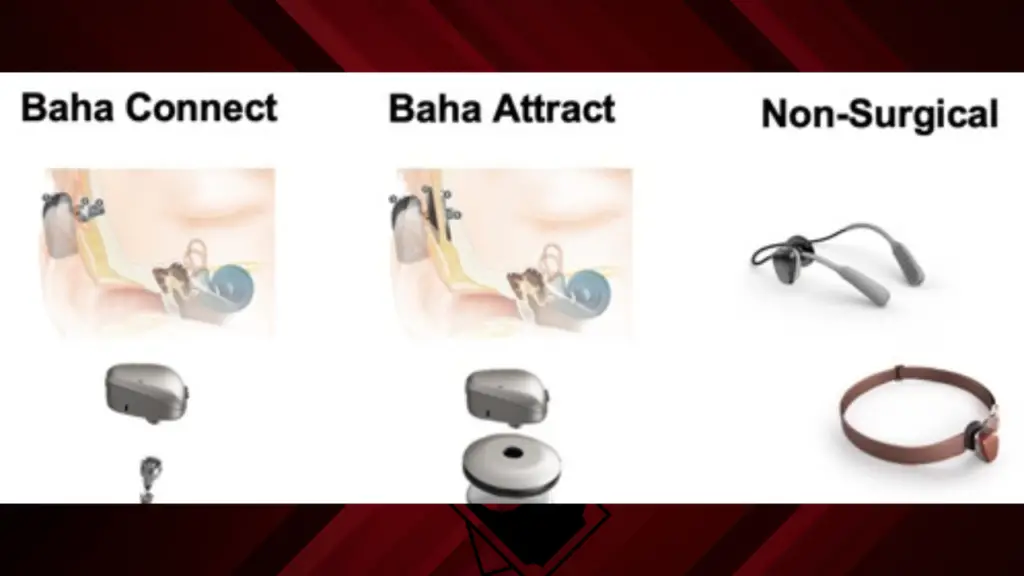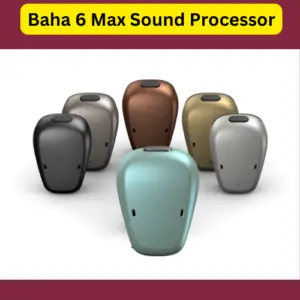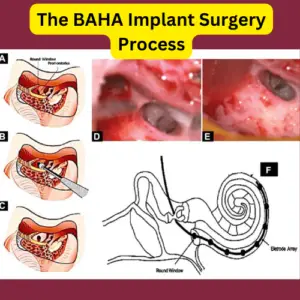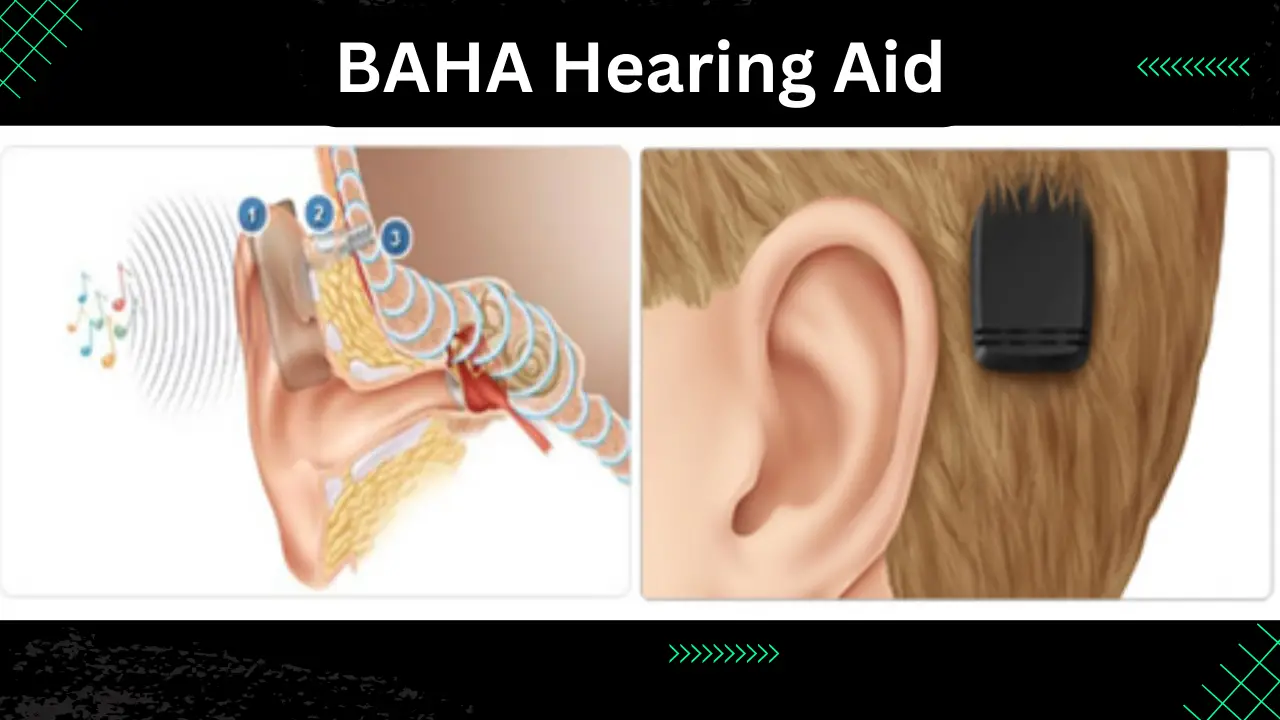Hear better with Baha hearing aids, a surgically implanted option for conductive, mixed, or single-sided deafness. Baha devices bypass the outer & middle ear, transmitting sound directly to the inner ear through the skull. Experience improved sound quality, clarity, and reduced noise in a natural-sounding way. No more whistling or feedback! Talk to your doctor or audiologist to see if Baha is right for you. Learn more about benefits, risks, and costs.
Introduction
For many individuals with hearing loss, traditional hearing aids offer a lifeline to reconnecting with the world around them. However, some face unique challenges due to ear canal malformations, chronic infections, or single-sided deafness. In these cases, where conventional solutions fall short, Baha hearing aids emerge as a revolutionary alternative, offering a distinct pathway to rediscovering the joy of sound.

What are Baha Hearing Aids?
Unlike traditional hearing aids that amplify sound traveling through the air, Baha devices leverage a remarkable technology called bone conduction. A small titanium implant, akin to a tiny screw, is surgically placed on the skull behind the ear. This implant serves as a platform for a sound processor, a discreet device responsible for capturing sound waves. The magic happens here: the processor converts these waves into vibrations and transmits them directly through the skull bone, bypassing the outer and middle ear entirely. This unique approach delivers sound vibrations straight to the inner ear, the auditory nerve’s gateway, creating a natural and clear listening experience for those who cannot benefit from conventional hearing aids.
Why is Baha Significant?
For individuals facing specific hearing challenges, Baha offers a beacon of hope:
- Conductive hearing loss: When sound waves struggle to reach the inner ear due to blockages in the outer or middle ear, Baha acts as a bypass, directly transmitting sound vibrations to the inner ear, restoring hearing ability.
- Mixed hearing loss: This combination of conductive and sensorineural hearing loss (inner ear damage) can be addressed by Baha’s ability to tackle the conductive component, significantly improving overall hearing.
- Single-sided deafness: Traditional hearing aids can struggle to provide adequate sound localization and clarity in cases where only one ear functions. Baha, worn on the deaf side, helps restore balance and improve spatial awareness, enriching the listening experience.
- Chronic ear infections: For individuals prone to ear infections, traditional hearing aids can be uncomfortable and impractical. Baha eliminates the need for devices within the ear canal, minimizing the risk of further infections.
Understanding BAHA
For individuals with specific hearing challenges, traditional hearing aids might not always be the optimal solution. In such cases, BAHA, or Bone-Anchored Hearing Aid, emerges as a revolutionary alternative, offering a unique pathway to improved hearing and enhanced quality of life.
What does BAHA stand for?
BAHA stands for Bone-Anchored Hearing Aid, or sometimes Bone-Anchored Hearing Implant (BAHI). While technically an implant, the term “aid” is more commonly used.
What are the key components of BAHA?
The BAHA system comprises two main parts:
- The Implant: This small titanium screw-like device is surgically implanted on the skull behind the ear. It acts as a stable platform for the sound processor.
- The Sound Processor: This discreet device sits on the implant and captures sound waves. It then converts these waves into vibrations and transmits them through the skull bone directly to the inner ear, bypassing the outer and middle ear entirely.
Why is BAHA important in hearing rehabilitation?
BAHA plays a crucial role in hearing rehabilitation for individuals with specific hearing loss conditions:
- Conductive hearing loss: When sound waves cannot reach the inner ear due to blockages in the outer or middle ear (e.g., chronic ear infections, malformations), BAHA bypasses these obstructions, delivering sound directly to the inner ear and restoring hearing ability.
- Mixed hearing loss: Combining conductive and sensorineural (inner ear) hearing loss, BAHA addresses the conductive component, significantly improving overall hearing.
- Single-sided deafness: Unlike traditional hearing aids that struggle to provide spatial awareness in such cases, BAHA, worn on the deaf side, restores balance and improves sound localization, enriching the listening experience.
- Chronic ear infections: For individuals prone to infections, BAHA eliminates the need for devices within the ear canal, minimizing the risk of further issues.
Beyond specific conditions, BAHA offers unique advantages:
- Improved sound quality: Bone conduction transmits sound vibrations more efficiently, resulting in a richer and clearer listening experience.
- Reduced background noise: Sound travels directly to the inner ear, minimizing interference from external noise, and making conversations and social interactions easier.
- Greater comfort and stability: No earmolds or inserts ensure a comfortable and secure fit throughout the day.
- Improved cosmetic appeal: The discreet implant and processor offer a more aesthetically pleasing solution.
How BAHA Works
While traditional hearing aids amplify sound waves traveling through the air, Baha hearing aids employ a fascinating technology called bone conduction to deliver sound directly to the inner ear. Let’s delve into the mechanics behind this remarkable innovation:
The Power of Bone Conduction:
Imagine sound waves not just vibrating the eardrum but directly reaching the inner ear through your skull bones. That’s the essence of bone conduction. Sound waves, when converted into vibrations, travel through the bones of your skull, bypassing the outer and middle ear entirely. These vibrations reach the inner ear’s cochlea, stimulating the auditory nerve and creating a perception of sound.
The BAHA Mechanism:
- Sound Capture: The Baha sound processor, worn on the implant, acts like a microphone, capturing sound waves from the environment.
- Vibration Conversion: These waves are then converted into tiny vibrations using a miniature transducer within the processor.
- Transmission through Bone: The vibrations travel through the implant and directly into the skull bone behind the ear.
- Inner Ear Stimulation: These vibrations reach the cochlea in the inner ear, stimulating the auditory nerve and creating the perception of sound.
Key Advantages of Bone Conduction:
- Clarity and Richness: Bone conduction bypasses the outer and middle ear, which can sometimes dampen or distort sound. This results in a clearer and richer sound experience for many Baha users.
- Reduced Background Noise: As vibrations travel directly to the inner ear, external noise has less impact on the perceived sound. This makes Baha particularly beneficial in noisy environments.
- Minimal Feedback: Unlike traditional hearing aids that can experience feedback loops, bone conduction minimizes this issue due to the direct transmission path.
Beyond the Basics:
While the core mechanism is straightforward, there are additional factors influencing Baha’s functionality:
- Implant Placement: The specific location of the implant on the skull can impact sound quality and directionality.
- Individual Anatomy: The shape and density of the skull bone can influence how vibrations travel, leading to personalized experiences.
- Sound Processor Settings: The processor can be fine-tuned by an audiologist to optimize sound quality and clarity for each individual.
Understanding the limitations:
While bone conduction offers numerous benefits, it’s important to be aware of its limitations:
- Not suitable for all: Bone conduction may not be the best solution for individuals with specific types of hearing loss, such as severe sensorineural hearing loss.
- Cost considerations: Baha is a more expensive option compared to traditional hearing aids.
- Surgical procedure: The implant requires a minor surgical procedure, which carries potential risks and requires healing time.
Benefits of BAHA
Baha hearing aids offer a unique solution for individuals with specific hearing challenges, but their benefits extend far beyond simply regaining the ability to hear. Let’s dive into the key advantages that set Baha apart:
1. Enhanced Sound Quality:
- Direct Transmission: Bone conduction bypasses the outer and middle ear, which can introduce distortions or dampening. This direct path delivers richer, clearer sound, often described as more natural than traditional hearing aids.
- Minimized Feedback: The direct transmission also reduces the likelihood of the annoying whistling sound (feedback) sometimes experienced with traditional hearing aids.
2. Superior Directional Hearing:
- Natural Localization: Bone conduction utilizes the skull’s natural ability to transmit sound directionally, enabling users to better identify where sounds are coming from in noisy environments. This is particularly beneficial for individuals with single-sided deafness who struggle with sound localization using traditional aids.
3. Unmatched Comfort and Convenience:
- No Ear Inserts: Eliminating the need for earmolds or inserts translates to unparalleled comfort, especially for individuals with sensitive ears or chronic ear infections.
- Secure and Discreet: The implant sits comfortably under the skin, and the sound processor is small and discreet, providing aesthetic appeal and confidence.
4. Ideal for Single-Sided Deafness:
- Bridging the Gap: Traditional hearing aids struggle to provide spatial awareness and clear sound localization for individuals with single-sided deafness. Baha, worn on the deaf side, restores balance and improves sound localization, significantly enriching their listening experience.
5. Customized Solutions:
- Tailored Sound Processing: Audiologists can fine-tune the sound processor to match individual hearing needs and preferences, ensuring optimal performance.
- Variety of Processors: Different processor options are available to cater to various lifestyles and aesthetic preferences.
It’s important to remember:
- While these benefits are significant, Baha might not be suitable for all types of hearing loss. Consulting a qualified audiologist is crucial for understanding if it’s the right solution for you.
- Baha requires a surgical procedure, so potential risks and healing time need to be considered.
- Compared to traditional hearing aids, Baha tends to be a more expensive option.
BAHA Hearing Aid Information (What And How)
| Feature | Information |
|---|---|
| Device Type | Surgically implanted hearing aid |
| Hearing Loss Addressed | Conductive, mixed, single-sided deafness |
| Function | Transmits sound through skull bone to inner ear |
| Components | Implant (titanium screw), Sound processor (microphone, processor, transducer) |
| Sound Transmission | Bypasses outer & middle ear |
Who Can Benefit from BAHA Hearing Aid?
Not everyone benefits from traditional hearing aids. If you face specific hearing challenges, Baha hearing aids could be a game-changer. Let’s explore who can truly experience the transformative power of BAHA:
1. Individuals with Conductive Hearing Loss:
- This type of hearing loss occurs when sound waves struggle to reach the inner ear due to blockages in the outer or middle ear. For example, chronic ear infections, malformations, or cholesteatoma can obstruct sound transmission.
- Baha bypasses these obstructions, transmitting sound vibrations directly through the skull bone to the inner ear, effectively restoring hearing ability.
2. Individuals with Mixed Hearing Loss:
- This combines conductive hearing loss with sensorineural hearing loss (damage to the inner ear itself).
- While Baha cannot address the sensorineural component, it effectively tackles the conductive aspect, significantly improving overall hearing and clarity.
3. Individuals with Single-Sided Deafness:
- Traditional hearing aids can struggle to provide adequate sound localization and clarity in cases where only one ear functions properly.
- Baha, worn on the deaf side, acts as a bridge, transmitting sound vibrations directly to the inner ear. This restores balance and improves spatial awareness, enriching the listening experience and boosting confidence in social situations.
4. Those with Chronic Ear Infections or Ear Canal Abnormalities:
- Individuals prone to chronic ear infections or those with ear canal malformations often find traditional hearing aids uncomfortable or impractical.
- Baha eliminates the need for devices within the ear canal, minimizing the risk of further infections and discomfort.
5. People Unable to Wear Traditional Hearing Aids:
- Individuals who cannot wear traditional hearing aids due to allergies, discomfort, or physical limitations can find solace in Baha’s secure and comfortable implant-based design.
Benefits and Drawbacks
| Benefit | Drawback |
|---|---|
| Improved hearing in noise | Surgical procedure required |
| Better sound quality & clarity | Potential for infection & rejection |
| More natural sound | Skin irritation possible |
| No feedback or whistling | Cost: $10,000-$15,000 |
| Comfortable to wear | Not suitable for all types of hearing loss |
BAHA vs. Traditional Hearing Aids
Both BAHA and traditional hearing aids aim to improve hearing ability, but they work differently and cater to varying needs. Here’s a comprehensive comparison to help you choose the right option:
Functionality:
- Technology:
- BAHA: Bone conduction transmits sound vibrations directly through the skull bone to the inner ear, bypassing the outer and middle ear.
- Traditional Hearing Aids: Air conduction amplifies sound waves traveling through the ear canal to the eardrum and then to the inner ear.
- Suitability:
- BAHA: Conductive hearing loss, mixed hearing loss (conductive component), single-sided deafness, chronic ear infections, ear canal malformations, and individuals unable to wear traditional aids.
- Traditional Hearing Aids: Most types of hearing loss, including sensorineural hearing loss, mild to severe conductive hearing loss.
Benefits:
- Sound Quality:
- BAHA: Often described as richer, clearer, and more natural due to direct transmission.
- Traditional Hearing Aids: Varies depending on type and quality, but can be clear and effective for many users.
- Directional Hearing:
- BAHA: Excellent due to natural skull bone conduction, improving sound localization in noisy environments.
- Traditional Hearing Aids: Can be good, but may struggle with complex environments or single-sided deafness.
- Comfort and Convenience:
- BAHA: No ear inserts, comfortable and secure fit, discreet.
- Traditional Hearing Aids: Can be comfortable with proper fit, but ear inserts might cause discomfort for some.
- Other Advantages:
- BAHA: Minimized feedback, good for chronic ear infections.
- Traditional Hearing Aids: Wider range of styles and price points.
Considerations:
- Surgery: BAHA requires a minor surgical procedure with healing time, while traditional aids don’t.
- Cost: BAHA is generally more expensive than traditional aids.
- Maintenance: Both require regular cleaning and maintenance.
Choosing the Right BAHA System
For individuals with specific hearing challenges, choosing the right BAHA system is crucial to maximizing the benefits and optimizing their hearing experience. Let’s delve into the key factors to consider and explore the available BAHA models:
Factors Influencing Your Choice:
- Degree of Hearing Loss: The severity and type of hearing loss (conductive, mixed, single-sided deafness) play a significant role. Consult your audiologist to understand which BAHA system effectively addresses your specific needs.
- Lifestyle: Consider your daily activities and environments. If you lead an active lifestyle or spend time in noisy settings, prioritizing features like sweat resistance and directional hearing might be important.
- Comfort and Aesthetics: Baha offers discreet and comfortable options, but individual preferences vary. Discuss different implant and processor styles with your audiologist to find the perfect fit.
- Budget: Baha systems are generally more expensive than traditional hearing aids. Explore available insurance coverage and financing options to make informed choices.
Exploring BAHA Hearing Aid Models and Styles:
Currently, Cochlear is the leading manufacturer of Baha systems. Here’s a quick overview of their main offerings:

Implants:
- Baha Attract System: This is the standard implant option, suitable for most individuals with conductive or mixed hearing loss.
- Baha Connect System: This implant offers higher power output, ideal for severe hearing loss and single-sided deafness.
Sound Processors:

- Baha 6 Max Sound Processor: Compatible with both implant systems, offering a range of features like noise reduction and personalization options.
- Baha 5 Sound Processor: A basic and affordable option for simple listening needs.
- Baha 4 Processor: This discreet option integrates seamlessly with the implant for a near-invisible appearance.
Additional Considerations:
- Upgradability: Some systems offer the ability to upgrade processors in the future as your needs evolve.
- Warranty and Support: Ensure you understand the warranty coverage and support options available before making a decision.
The BAHA Implant Surgery Process

Deciding on a BAHA implant is a significant step towards improved hearing. Understanding the surgical process helps manage expectations and prepare for a smooth journey. Let’s break down the key phases:
Pre-implant Evaluation and Assessment:
- Consultation and Evaluation: An audiologist and an ENT surgeon will assess your hearing needs, medical history, and suitability for BAHA. This involves audiometry tests, physical examinations, and discussions about your expectations.
- Imaging and Tests: CT scans or other imaging might be necessary to evaluate bone structure and determine the optimal implant placement.
- Informed Consent: After a thorough explanation of the procedure, risks, and benefits, you will be asked to sign informed consent forms.
Surgical Procedure: Implant Placement and Abutment Installation:
- Preparation: General or local anesthesia is used, and the area behind your ear is sterilized.
- Implant Placement: A small incision is made behind your ear. Using specialized tools, the surgeon creates a tiny hole in the skull bone and carefully inserts the titanium implant.
- Abutment Installation: A small post-like piece called the abutment is attached to the implant, acting as a platform for the sound processor.
- Closure and Stitches: The incision is closed with dissolvable sutures, and a sterile dressing is applied.
Postoperative Care and Rehabilitation:
- Recovery: Expect mild pain and swelling, managed with medication and ice packs. The healing period typically lasts 6-8 weeks.
- Wound Care: Follow instructions on cleaning the area and keeping it dry to prevent infection.
- Follow-up Appointments: Regular checkups with your doctor and audiologist are crucial to monitor healing and activate the processor once the implant is integrated.
- Rehabilitation: Your audiologist might recommend hearing therapy exercises to help your brain adjust to the new sound experience.
Additional Considerations:
- Risks and Complications: While infrequent, risks like infection, bleeding, or implant rejection exist. Discuss these in detail with your doctor.
- Recovery Time: The healing pace varies individually. Plan for activity restrictions during the initial healing period.
- Support: Family, friends, and support groups can play a crucial role in your recovery and adjustment to BAHA.
Remember, this is a general overview. Every individual’s experience may differ. Consulting your qualified audiologist and surgeon is essential to understand the personalized details of your BAHA surgery and receive tailored guidance for a successful outcome.
Additional Information
| Feature | Information |
|---|---|
| Technology Maturity | Relatively new, but proven safe & effective |
| Consultation Needed | Talk to doctor/audiologist for suitability |
| Availability | Various types available to meet individual needs |
Living with BAHA: Tips and Advice
Getting a BAHA implant signifies a new chapter in your hearing journey. While the implant itself offers remarkable potential, adjusting and maximizing its benefits requires knowledge and commitment. Let’s explore practical tips and insights to help you thrive with BAHA:
Adjusting to BAHA: Expectations and Challenges:
- Be Patient: Your brain needs time to adapt to the new sound experience. Allow yourself time to adjust and embrace the gradual improvements in your hearing ability.
- Manage Expectations: While BAHA offers significant improvement, it doesn’t restore normal hearing in all cases. Set realistic expectations based on your specific hearing loss and consult your audiologist for guidance.
- Expect Challenges: Tinnitus (ringing in the ears) or temporary sound distortions are common initially. These usually subside as your brain adjusts. Discuss any concerns with your audiologist.
Maintenance and Care of BAHA Device:
- Cleaning: Regularly clean the implant area and sound processor following the manufacturer’s instructions.
- Battery Care: Use recommended batteries and replace them promptly to avoid sound disruptions.
- Moisture Protection: Protect your BAHA from excessive water exposure, especially swimming or showering.
- Regular Checkups: Schedule regular appointments with your audiologist for device checks, adjustments, and cleanings.
Maximizing Benefits and Overcoming Limitations:
- Personalization: Work with your audiologist to fine-tune the sound processor settings for optimal clarity and comfort.
- Noise Management Strategies: Utilize hearing assistive technologies like directional microphones or background noise reduction features in your sound processor.
- Communication Tips: Communicate your hearing needs to others and advocate for yourself in social situations.
- Support Groups: Connect with other BAHA users for valuable shared experiences and advice.
Additional Tips:
- Practice Listening: Actively engage in listening activities like listening to music or audiobooks to train your brain and enhance sound perception.
- Be Patient with Yourself: Adjusting to BAHA takes time and effort. Be patient with yourself and celebrate your progress along the way.
- Embrace the Change: Focus on the positive impacts of improved hearing, from clearer conversations to richer soundscapes.
Consulting with a Hearing Healthcare Professional
Choosing a BAHA system is a crucial decision that significantly impacts your hearing journey. While this blog provided insights and information, navigating the complexities of hearing loss and selecting the right solution requires the expertise of a qualified hearing healthcare professional. Let’s emphasize the importance of seeking professional guidance and offer tips on finding the right specialist:
Why is Consulting a Professional Crucial?
- Accurate Diagnosis and Assessment: Only a qualified audiologist or otolaryngologist (ENT) can accurately diagnose your hearing loss type and severity, helping determine if BAHA is the optimal solution for you.
- Individualized Recommendations: Hearing needs and preferences vary greatly. A professional can assess your specific needs, lifestyle, and budget to recommend the most suitable BAHA system configuration.
- Surgical Expertise: For the implant procedure, collaborating with a skilled ENT surgeon experienced in BAHA implantation ensures optimal outcomes and minimizes potential risks.
- Ongoing Support and Care: Choosing BAHA means embarking on a long-term journey. A qualified professional will provide ongoing monitoring, device adjustments, and rehabilitation guidance throughout your journey.
- Addressing Concerns and Questions: No matter how much you research, questions and concerns are natural. A professional can address your anxieties, clarify doubts, and offer personalized guidance for confident decision-making.
Finding the Right Specialist:
- Ask Your Primary Care Physician: Start by seeking a referral from your doctor to an audiologist or ENT specializing in hearing loss and BAHA systems.
- Look for Professional Certifications: Verify that the chosen professional holds relevant certifications and has significant experience with BAHA implants.
- Seek Peer Recommendations: Talk to friends, family, or support groups for recommendations of skilled and patient-centered professionals.
- Schedule Consultations: Don’t hesitate to schedule consultations with several specialists to find someone who understands your unique needs and makes you feel comfortable.
Conclusion
Our exploration of BAHA has touched upon its remarkable capabilities and potentially life-changing impact on individuals facing specific hearing challenges. We’ve delved into the technology, benefits, and considerations surrounding this innovative solution.
Let’s recap the key takeaways:
- BAHA offers a unique approach to hearing: Bypassing the outer and middle ear, it transmits sound vibrations directly through the skull bone to the inner ear, restoring hearing for those who cannot utilize traditional hearing aids.
- This technology benefits many: Individuals with conductive hearing loss, mixed hearing loss (conductive component), single-sided deafness, chronic ear infections, or ear canal malformations can experience significant improvements in hearing clarity and quality.
- Beyond hearing restoration, BAHA offers unique advantages: Clearer sound, superior directional hearing, comfort, and discretion are just some of the benefits that set it apart.
- However, BAHA isn’t for everyone: Consulting a qualified audiologist is crucial to assess your specific needs and determine if BAHA is the right solution for you.
- The journey involves informed decisions: Understanding the surgical process, recovery, and long-term care is essential for a smooth and successful experience.
Additional Resources
Websites:
- American Academy of Audiology:
- American Speech-Language-Hearing Association:
- The Hearing Loss Association of America:
Organizations:
- American Cochlear Implant Alliance:
- National Institute on Deafness and Other Communication Disorders (NIDCD):
Further Reading:
Read More On Hearing Aids:
Hearing Aid Alternatives-Unveiling Your Path to Clearer Sound
Understanding Unilateral Hearing Loss: Causes, Effects, and Coping Strategies

